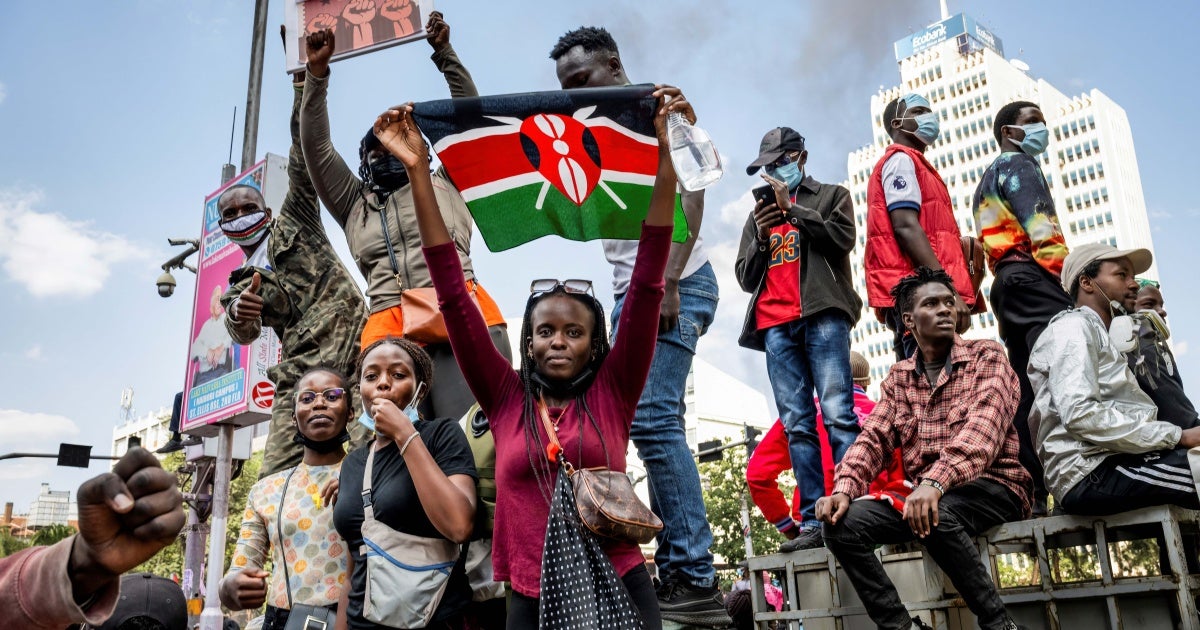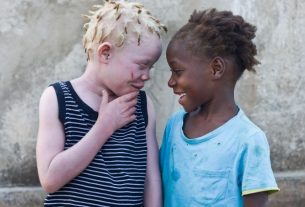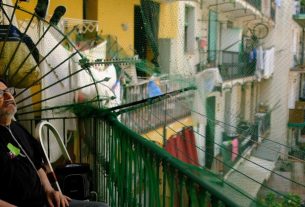(Nairobi) – Kenyan security forces shot directly into crowds of protesters on June 25, 2024, including protesters who were fleeing, Human Rights Watch said today.
Protests began in cities and towns across Kenya and online after the Finance Bill 2024 was introduced in parliament on June 18. The protests have been organized largely by Kenyans between the ages of 18 and 35, airing their grievances notably through social media. They expressed outrage over provisions of the bill that would raise taxes on goods and services that many people depend on, such as bread, and on mobile money transfers, to meet International Monetary Fund (IMF) revenue targets. Government spending on social programs has already been steadily decreasing and reports of wasteful public spending with impunity abound.
“Shooting directly into crowds without justification, including as protesters try to flee, is completely unacceptable under Kenyan and international law,” said Otsieno Namwaya, associate Africa director at Human Rights Watch. “The Kenyan authorities need to make clear to their forces that they should be protecting peaceful protesters and that impunity for police violence can no longer be tolerated.”
Kenyan authorities should ensure that security agencies deployed to protests protect the right to peaceful protest and refrain from using excessive and lethal force, Human Rights Watch said. The authorities should take immediate steps to investigate the killings of over two dozen people protesting the government’s proposed tax measures. On May 26, the president announced that he would not sign the Finance Bill and was instead sending it back to parliament with a proposal to delete all the clauses. He also said he would introduce austerity measures across the executive branch.
On June 25, protesters gathered in cities and towns across the country, including outside of parliament in Nairobi. In the afternoon, as parliament was meeting, the police opened fire on protesters in and around parliament, witnesses and journalists told Human Rights Watch. Although there is no confirmation on the exact number of people killed in Nairobi and other towns, Human Rights Watch found that at least 30 people had been killed on that day based on witness accounts, publicly available information, hospital and mortuary records in Nairobi, as well as witness accounts in Nakuru, Eldoret, and Meru. The Police Reforms Working Group – Kenya reported that 23 people had also been shot dead by the police by the evening of June 25, most of them over the course of the previous week.
Human Rights Watch interviewed 11 people including three family members of victims, a mortuary attendant, two parliamentary staff present in parliament on the afternoon of June 25, two photojournalists covering the protests, and three human rights activists involved in efforts to locate many of those missing in various parts of the country.
The journalists and parliamentary staff said that around 2 p.m., the General Service Unit, a paramilitary force deployed around the parliament, shot directly at unarmed people attempting to force their way into the National Assembly. Media reported that eight protesters were killed, though the actual number is most likely higher. At around 4 p.m., protesters breached the security and perimeter walls and stormed parliament, forcing legislators to seek shelter in other parts of the building.
Media reported that the General Service Unit and military forces were deployed around 5 p.m. to rescue the lawmakers. Five witnesses said that some members of the security forces shot indiscriminately at fleeing protesters, killing an unknown number. Footage on KTN TV at around 5 p.m. captured police beating and shooting at fleeing protesters inside the precincts of parliament.
The two journalists and one parliamentary staff member said they saw armed personnel on the parliament building roof and on top of the 28-floor Kenyatta International Conference Centre shooting at protesters.
At least three people interviewed, including one family member of a young man who was killed, said that at around 5:30 p.m. in the Githurai area of Nairobi, several military officers from Kahawa Barracks arrived to find a section of the Nairobi-Thika Highway barricaded with stones by protesters, who had set a police anti-riot vehicle on fire.
A human rights activist in the area said that when the military officers arrived, “Eight military officers came out and just opened fire on people. They killed several people, including those who were not part of the protests. It is not known how many people in total were killed, but at around 8 p.m. when the military officers stopped shooting at people, we confirmed at least 22 were dead.” The activist said that the shooting by the military joined by the police resumed at 10 p.m. and continued until 11 p.m. Police told the media that 20 of their officers were injured in Githurai after more than 6,000 youth attacked them. The Law Society of Kenya has called for an independent investigation into the events in Githurai.
On June 26, Human Rights Watch visited Kenyatta National Hospital’s mortuary and saw six bodies of protesters that hospital records showed had been brought in by officers from both the Nairobi central police station and Kamukunji police station. Researchers found six more bodies at the Nairobi City Mortuary brought in by officers from Kamukunji police station, along with an additional six at Mama Lucy Hospital and eight at Kenyatta University Referral Hospital. Human Rights Watch research shows that police killed at least three people in the town of Eldoret, one person in Nakuru, and one in Meru.
Researchers also visited several hospital wards where hospital officials said that at least 165 people injured during the protests on June 25 had been admitted. A doctor at Kenyatta National Hospital said that two were dead on arrival, 24 needed immediate surgery, and 72 were treated for injuries and discharged. The majority of those admitted had blunt force trauma injuries from being hit by kinetic impact projectiles and bullet wounds.
Several people told Human Rights Watch that their relatives are missing. Kenyan authorities should provide timely information about the whereabouts and situation of people reported missing, Human Rights Watch said.
On June 24, pro-government protesters erected pro-Finance Bill 2024 banners in downtown Nairobi. Two human rights activists who participated in the anti-Finance Bill protests said that on the morning of June 25, the pro-government protesters briefly clashed with the anti-Finance Bill protesters in downtown Nairobi and in Eldoret town. Kenyan media reported that pro-government protesters in Eldoret, who chanted war songs, were back on the streets on June 27, this time armed with batons, bows, and arrows, but later returned their weapons to the Eldoret county government offices on the evening of June 27.
Speaking to the media on the evening of June 25, President William Ruto described protesters as “treasonous” and “organized criminals” who hijacked the protests to cause mayhem. He also announced the deployment of the army to support the police.
Kenyan human rights groups have criticized the president for deploying the military without getting the parliamentary approval required under Kenyan law. The Law Society of Kenya challenged the constitutionality and sequencing of the deployment in court, and on June 27 the High Court ruled that the deployment was legal and necessary, giving the cabinet secretary two days to regularize the deployment by publishing in the official government gazette details about the area, duration, and nature of the deployment as required by Kenyan law. Military forces were deployed in several parts of Nairobi at renewed protests on June 27. Meanwhile, the Kenya National Commission on Human Rights said it would launch an inquiry into the excessive use of force and indiscriminate shooting by the security forces.
Kenya’s international partners should continue to actively monitor the situation and any likely prosecutions resulting from the protests, and further urge Kenyan authorities to speedily but credibly and transparently investigate abuses by the security forces, Human Rights Watch said. International human rights bodies, including the African Commission on Human and Peoples’ Rights and UN special rapporteurs, should monitor the crisis and consider requesting to visit Kenya to investigate any alleged abuses. The authorities should grant the special rapporteurs together with other independent rights monitors access to conduct such investigations, Human Rights Watch said.
The Finance Bill 2024 was introduced in the context of an IMF program approved in 2021. It includes several revenue-raising measures that would increase the costs of many goods and services essential for rights, particularly for Kenyans with lower and middle incomes and for women. The IMF program introduced sweeping reforms, some of which have already exacerbated a cost-of-living crisis. The bill was expected to raise an additional US$2.3 billion in the next fiscal year, in part to meet IMF requirements to increase revenues.
The IMF should assess the conditions of its program with Kenya, revising them and the social spending floor to ensure that the program is not exacerbating poverty or inequality or preventing the government from meeting its human rights obligations, Human Rights Watch said.
“Widespread outrage should be a wake-up call to the Kenyan government and the IMF that they cannot sacrifice rights in the name of economic recovery,” Namwaya said. “Economic sustainability can only be achieved by building a new social contract that raises revenues fairly, manages them responsibly, and funds services and programs that protect everyone’s rights.”



